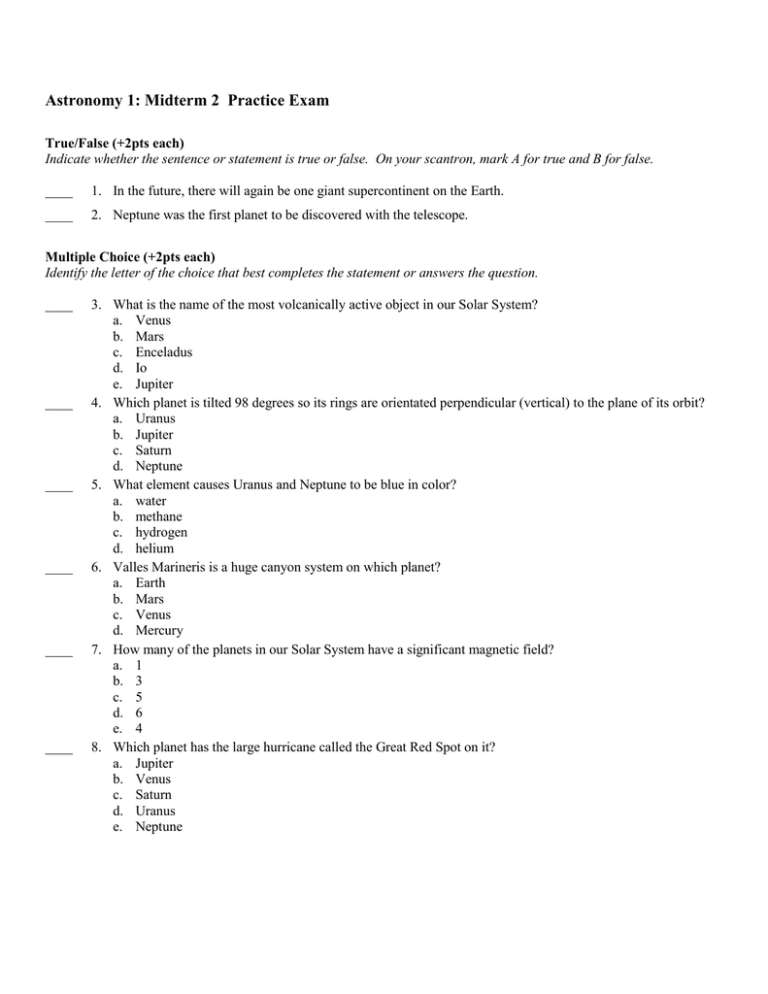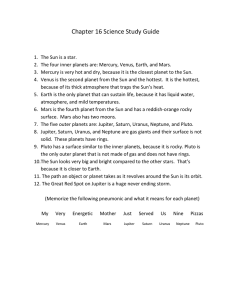Astronomy 1: Midterm 2 Practice Exam
advertisement

Astronomy 1: Midterm 2 Practice Exam True/False (+2pts each) Indicate whether the sentence or statement is true or false. On your scantron, mark A for true and B for false. ____ 1. In the future, there will again be one giant supercontinent on the Earth. ____ 2. Neptune was the first planet to be discovered with the telescope. Multiple Choice (+2pts each) Identify the letter of the choice that best completes the statement or answers the question. ____ ____ ____ ____ ____ ____ 3. What is the name of the most volcanically active object in our Solar System? a. Venus b. Mars c. Enceladus d. Io e. Jupiter 4. Which planet is tilted 98 degrees so its rings are orientated perpendicular (vertical) to the plane of its orbit? a. Uranus b. Jupiter c. Saturn d. Neptune 5. What element causes Uranus and Neptune to be blue in color? a. water b. methane c. hydrogen d. helium 6. Valles Marineris is a huge canyon system on which planet? a. Earth b. Mars c. Venus d. Mercury 7. How many of the planets in our Solar System have a significant magnetic field? a. 1 b. 3 c. 5 d. 6 e. 4 8. Which planet has the large hurricane called the Great Red Spot on it? a. Jupiter b. Venus c. Saturn d. Uranus e. Neptune ____ ____ ____ ____ ____ ____ ____ ____ ____ 9. Adaptive optics is a. using a deformable mirror to counteract the scattering of light from the atmosphere. b. the correction for chromatic aberration in a lens. c. using several telescopes together as one in order to increase resolution. d. the correction for spherical aberration of a mirror. 10. What produced most of the oxygen in the Earth’s atmosphere 2 billion years ago? a. photosynthesis by cyanobacteria b. gases released from volcanic eruptions c. photosynthesis by trees d. gases released from comet and asteroid impacts 11. What is Pluto’s largest moon called? a. Sedna b. Eris c. Charon d. Ceres 12. In order to have a significant magnetic field what two properties does a planet have to possess? a. slow rotation and liquid metallic interior b. slow rotation and solid interior c. fast rotation and solid interior d. fast rotation and liquid metallic interior 13. The magnetic field of the Earth is important to humans because it a. prevents solar flares from occurring. b. blocks out most of the harmful ultra-violet radiation from the Sun. c. blocks most of the dangerous charged particles released by the solar wind. d. prevents global warming from occurring. 14. What is the most massive planet in our Solar System? a. Saturn b. Neptune c. Earth d. Saturn e. Mars f. Jupiter 15. Which of the following functions depend upon the diameter of the telescope? a. resolution and magnification. b. light gathering power, resolution, and magnification. c. light gathering power and resolution. d. light gathering power and magnification. 16. Which of the following people invented the first telescope? a. Isaac Newton b. Hans Lippershey c. Galileo Galilei d. Johannes Kepler 17. What two elements currently dominate the Earth’s atmosphere? a. hydrogen and oxygen b. carbon dioxide and oxygen c. nitrogen and oxygen d. hydrogen and helium ____ 18. Which of the following everyday item is most closely related to the charge-coupled device (CCD)? a. digital camera b. compact disc c. GPS navigation d. cell phone e. computer chip ____ 19. Interferometry is a. the correction for chromatic aberration in lens. b. the correction for spherical aberration of a mirror. c. using several telescopes together as one in order to increase resolution. d. using a deformable mirror to counteract the scattering of light from the atmosphere. ____ 20. What is the best reason why Mars is red in color? a. Because it has a lot of volcanic activity which produces lava all over its surface. b. Because it has a thin atmosphere of carbon dioxide that reflects mostly red light. c. Because the ice on Mars reflects mostly red light. d. Because it has iron oxide all over its surface. ____ 21. How many of the planets in our Solar System have rings? a. 3 b. 2 c. 4 d. 5 e. 1 Completion (+1pt) Complete each sentence or statement. 22. What is the name of another object in our Solar System besides the Earth and Mars that could potentially have liquid water on it? ____________________ 23. What type of object is Pluto now according to the IAU? _______________________ 24. What is the lunar soil that consists of very fine sandy material on the Moon called? _________________ Short Answer (+2pts each) 25. How did the ozone layer affect the evolution of life on Earth? 26. Scientists have discovered compelling evidence for past and current liquid water on Mars. Describe two discoveries that were made of Mars that demonstrates liquid water has existed or still exists on Mars. Short Answer (+3pts) 27. a) What is happening to the distance of the Moon, is it moving farther away or getting closer to the Earth? b) What is causing the Moon’s distance to change over time? (+3pts) Short Answer (+4pts to 5pts each) 28. a) When did our Solar System form? (+1pt) c) Describe in detail how our Sun and our planets were formed (+3pts) 29. a) List the names of the inner/terrestrial planets in their correct order from the Sun. (+2pts all or nothing) b) List the names of the outer/Jovian planets in the correct order from the Sun. (+2pts all or nothing)




